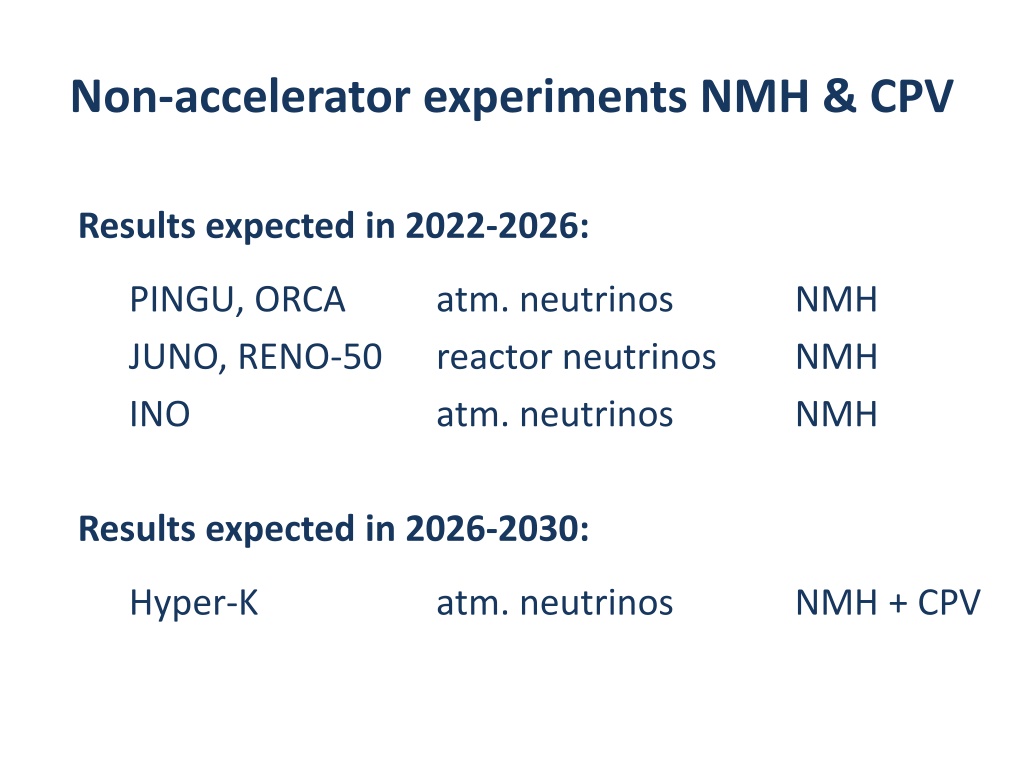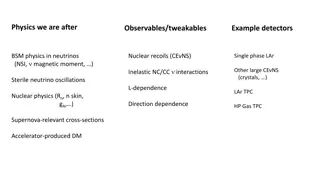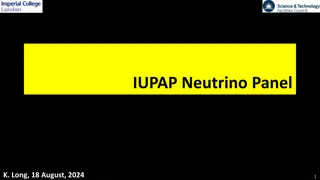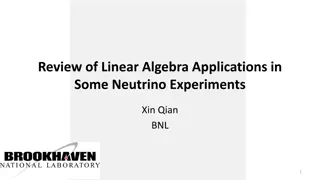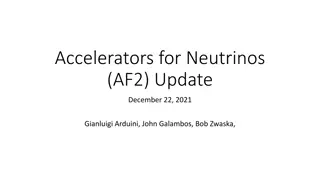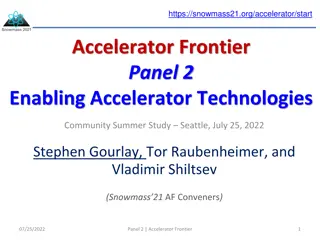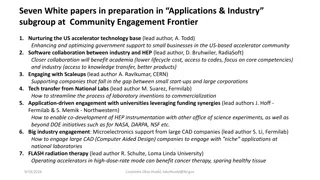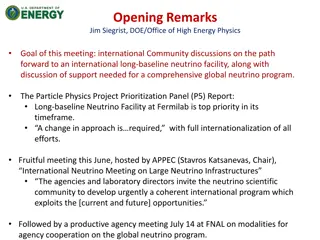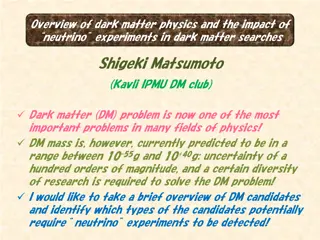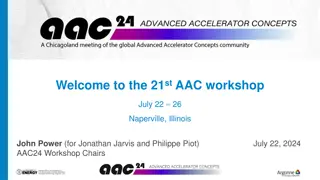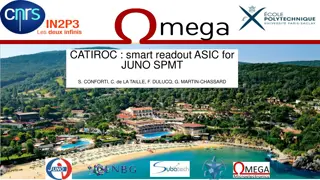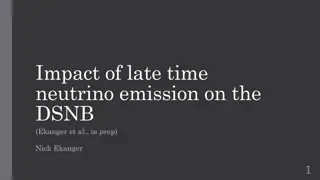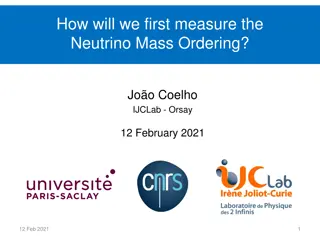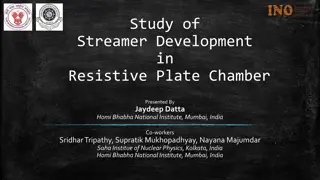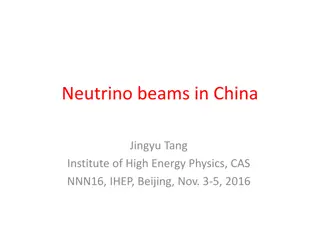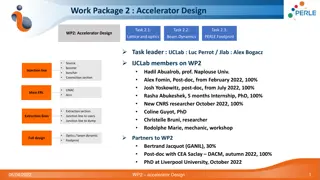Overview of Non-Accelerator Neutrino Experiments and Programs
Non-accelerator experiments in the field of neutrino physics are expected to yield significant results between 2022 and 2030. Projects like PINGU, ORCA, JUNO, RENO-50, INO, Hyper-K, and DUNE aim to study neutrino mass hierarchy, CP violation, and non-oscillation phenomena. The design and construction details of ORCA, PINGU, and related predecessors are highlighted, along with their potential impact on understanding neutrino properties. The significance of these experiments in improving our knowledge of neutrino physics is discussed, considering factors like time scales, systematic uncertainties, and detector optimization.
- Neutrino Physics
- Experimental Science
- Non-Accelerator Experiments
- Neutrino Mass Hierarchy
- Neutrino Oscillation
Download Presentation

Please find below an Image/Link to download the presentation.
The content on the website is provided AS IS for your information and personal use only. It may not be sold, licensed, or shared on other websites without obtaining consent from the author. Download presentation by click this link. If you encounter any issues during the download, it is possible that the publisher has removed the file from their server.
E N D
Presentation Transcript
Non-accelerator experiments NMH & CPV Results expected in 2022-2026: PINGU, ORCA JUNO, RENO-50 INO atm. neutrinos reactor neutrinos atm. neutrinos NMH NMH NMH Results expected in 2026-2030: Hyper-K atm. neutrinos NMH + CPV
Non-oscillation programs PINGU and ORCA: SN neutrinos (just time profile and mean -energy) low-energy GRB WIMPs, Exotic particles (Magn. Monopoles etc.) JUNO and RENO-50: p-decay SN neutrinos Geo-neutrinos Hyper-K: Solar neutrinos p-decay SN neutrinos (incl. relic SN) WIMPs, Exotics (magnetic monopoles etc.) INO: Atm. nu and anti-nu separately Precision study of HE muon energy loss SN neutrinos WIMPs, Exotics (Magnetic Monopoles etc.) DUNE: p-decay SN neutrinos (incl. relic neutrinos) Solar neutrinos
PINGU and ORCA Predecessors Amanda (turned of 2009) IceCube with DeepCore Part of IceCube-Gen2 PINGU High-energy extension Surface veto Predecessor ANTARES Part of KM3NeT ORCA ARCA for high energy astronomy Can detect cosmic neutrinos ! Can do competetive oscilllation physics
Design ORCA PINGU 40 new strings + 9 old strings 115 strings 60 80-96 DOM/string 18 mDOMs/string
Design PINGU ORCA 40 new strings + 9 old strings 115 strings 60 80-96 DOM/string 18 mDOMs/string Effective mass ~ 2.5 Mt (5 GeV) Effective mass ~ 2.5 Mt 3.5 Mt (10 GeV) ~ 3.5 Mt Construction 2017-2020 Construction 2020-2023 Cost ~ 70 M$ Cost ~ 50 M
Design PINGU ORCA 40 new strings + 9 old strings 115 strings 60 80-96 DOM/string 18 mDOMs/string Effective mass ~ 2.5 Mt (5 GeV) Effective mass ~ 2.5 Mt 3.5 Mt (10 GeV) ~ 3.5 Mt Construction 2017-2020 Construction 2020-2023 Cost ~ 50 M Chance to get the first 3 effect on NMH from a single experiment in 2023 Cost ~ 70 M$
Significance vs. time From PINGU LoI Need both tracks and cascades 3 after 3 years for sin 23 ~ 0.4 3 after 2 years for sin 23 ~ 0.5 3 after 1 year for sin 23 ~ 0.6 Would improve with better input on cross section and spectral shape Would improve with better analysis, detector optimization Could slightly worsen due to systematics
from PINGU LoI Systematics Impact on 1-year significance (1.75 ) Working on better understanding of systematic effects Expect more precise values for m 13, sin 13and sin 23 from reactor expts, T2K, NOvA, DeepCore, Expect more information on cross sections from accelerator experiments (interesting range 2 20 GeV)
Detector specific systematics Example downward veto, extrapolation to higher energies: PINGU is embedded in DeepCore DeepCore is embedded in IceCube Both act as extremely efficient veto against downward muons Atm spectrum is measured with high statistics/accuracy toward high energies normalization Example Flavor identification: ORCA: less light scattering, homogeneous medium better pattern recogniction better flavor ID below 10 GeV PINGU prelim. PINGU prelim. Complementary systematics due to detection medium and to detector configuration!
Conclusion on ORCA and PINGU PINGU and ORCA have very different systematics high complementarity! Both with ~ 3 after 3 years PINGU and ORCA will continue their successful cooperation on systematic effects and significance calculation Prototype results from 6 strings ORCA expected in 2016/17 Milestone 2017/18: Comparative process on science and technology, in particular the performance of prototypes and systematics. Very likely that two detectors at 2 different sites turn out to be the optimum approach.
